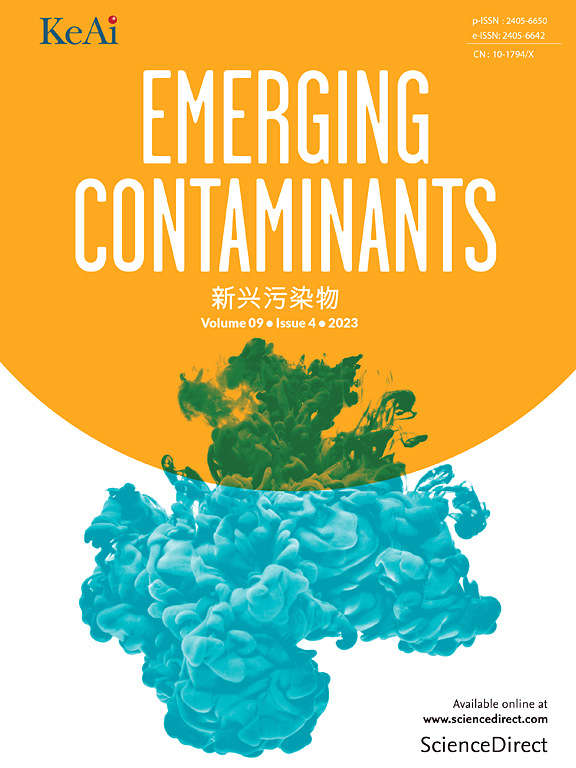埃塞俄比亚土壤中的多环芳烃:分布、来源和能源消费结构的含义
IF 5.3
2区 环境科学与生态学
Q1 ENVIRONMENTAL SCIENCES
引用次数: 0
摘要
多环芳烃(PAHs)是一种普遍存在于环境中的物质,与人类的能源消耗密切相关,可通过生物质不完全燃烧或石油排放释放到环境中。目前,特别是在非洲国家,关于能源消费结构(ECSs)与多环芳烃污染之间的关系存在知识差距。本研究调查了埃塞俄比亚土壤中16种重点多环芳烃化合物的分布、来源和风险(Σ16PAHs),并探讨了ECSs对多环芳烃污染的影响。Σ16PAHs的浓度范围为12.51 ~ 435.67 ng/g,在城乡梯度中呈下降趋势。基于诊断比和正矩阵分解(PMF)模型,生物质燃烧是最重要的来源。通过比较非洲国家的ECSs和多环芳烃浓度,发现ECSs的差异塑造了非洲多环芳烃来源和浓度的不同模式。增量终生癌症风险评估结果表明,多环芳烃对儿童、青少年和成人的风险较低。埃塞俄比亚政府一直在努力开发更清洁的能源,优化ECSs,以降低土壤多环芳烃浓度,降低潜在风险。本研究将为埃塞俄比亚改善能源结构管理提供支持。本文章由计算机程序翻译,如有差异,请以英文原文为准。

Polycyclic aromatic hydrocarbons in Ethiopian soils: Distribution, sources, and implication from energy consumption structures
Polycyclic aromatic hydrocarbons (PAHs), a ubiquitous substance in the environment, are closely associated with human energy consumption, which can be released to the environment from incomplete biomass combustion or emitted from petroleum. There is currently a knowledge gap on the relationships between energy consumption structures (ECSs) and PAH contamination, especially in African countries. This study investigated the distribution, sources, and risks of 16 prioritized PAH compounds (Σ16PAHs) in Ethiopian soils, and explored the impact of ECSs on PAH contamination. The concentrations of Σ16PAHs ranged from 12.51 to 435.67 ng/g, descending across an urban-rural gradient. Based on diagnostic ratios and positive matrix factorization (PMF) model, biomass combustion was the most important source. By comparing the ECSs and PAH concentrations in African countries, it was found that differences in ECSs shaped the diverse patterns of sources and concentrations of PAHs in Africa. The results of incremental lifetime cancer risk assessment suggested PAHs posed a low risk to children, adolescents, and adults. The Ethiopian government has been making continuous efforts to develop cleaner energy and optimize ECSs to decrease soil PAH concentrations and reduce potential risks. This study will provide support for Ethiopia to improve energy structure management.
求助全文
通过发布文献求助,成功后即可免费获取论文全文。
去求助
来源期刊

Emerging Contaminants
Medicine-Public Health, Environmental and Occupational Health
CiteScore
10.00
自引率
6.70%
发文量
35
审稿时长
44 days
期刊介绍:
Emerging Contaminants is an outlet for world-leading research addressing problems associated with environmental contamination caused by emerging contaminants and their solutions. Emerging contaminants are defined as chemicals that are not currently (or have been only recently) regulated and about which there exist concerns regarding their impact on human or ecological health. Examples of emerging contaminants include disinfection by-products, pharmaceutical and personal care products, persistent organic chemicals, and mercury etc. as well as their degradation products. We encourage papers addressing science that facilitates greater understanding of the nature, extent, and impacts of the presence of emerging contaminants in the environment; technology that exploits original principles to reduce and control their environmental presence; as well as the development, implementation and efficacy of national and international policies to protect human health and the environment from emerging contaminants.
 求助内容:
求助内容: 应助结果提醒方式:
应助结果提醒方式:


